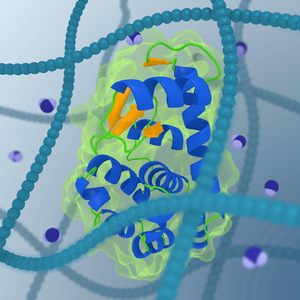Small protein molecules hardly "feel" the viscosity of the cytoplasm during their movement inside the cell. Researchers from the Institute of Physical Chemistry at the Polish Academy of Sciences have shown that this behavior can be comprehensively described for viscosity-dependent phenomena in solutions of different types and on separate scales. The discovery was used for studies regarding the cytoplasm of cancer cells.

The researchers, from the Institute of Physical Chemistry at the Polish Academy of Sciences, describe the changes in viscosity in a physically consistent manner, as measured in different solutions by detectors with sizes ranging from nanometers to micrometers. The findings were published in the scientific journal Nano Letters. "We have improved our formulas and previous conclusions so that a greater number of systems are successfully described, including the first ever description of cytoplasmic viscosity in cancer cells," says Professor Robert Hołyst.
The first scientific publication ever to address the viscosity of complex fluid systems was a paper by Albert Einstein from 1906. In the following years, interesting evidence emerged regarding the viscosity of the cytoplasm of biological cells. This evidence indicated that despite the high viscosity present in the cytoplasm, the mobility of small proteins in it is high - the speed is several orders of magnitude higher than the calculated speed.
The researchers from the Institute of Physical Chemistry at the Polish Academy of Sciences were able to describe the changes in viscosity using a single formula that includes several coefficients with identical physical characteristics. The coefficients provide a description both for the liquid medium (filled, for example, with a network of long-chain polymers or molecular clusters) and for the detector (ie, a protein molecule) moving within the medium. The new formula has universal relevance and can be used for detectors in a range of sizes, from nanometers to centimeters.
In their paper, the researchers used the new formula to describe the movement of DNA segments and other materials in healthy mouse cells and human cancer cells. "We were able to show that the viscosity of the liquid in the cell actually depends not only on the intracellular structure but also on the size of the detector used in the viscosity measurements," notes one of the research partners.
The researchers measured the limiting parameter for viscosity - proteins smaller than this length move freely in the cell. For the healthy cells this size was 7 nanometers and for the cancerous cells - 5 nanometers. Another parameter that affects the movement is the hydrodynamic radius of the liquid. This parameter is important since detectors larger than the hydrodynamic radius experience macroscopic viscosity. It was found that in the cancerous cells the macroscopic viscosity appeared for detectors with a length higher than 350 nm, while for the healthy cells the length was only 120 nm. "Our research gave birth to an innovative method for characterizing the cell structure - by measuring the viscosity of the cytoplasm," emphasizes the lead researcher.
The research findings could allow researchers to more effectively estimate the movement time of drugs introduced into cells, and could also be applied in the fields of nanotechnology, for example, in the production of nanoparticles with micellar solutions. The research findings are also important for advanced measurement methods, such as dynamic light scattering, which allows examining suspensions of molecules as a function of their size.

2 תגובות
Yossi, there is no planning in these things, but mostly reactions to events.
Recently, I got the impression that the emphasis on your website has been shifted from actual scientific news to news "about science". I would very much like you to return to the previous format.